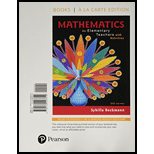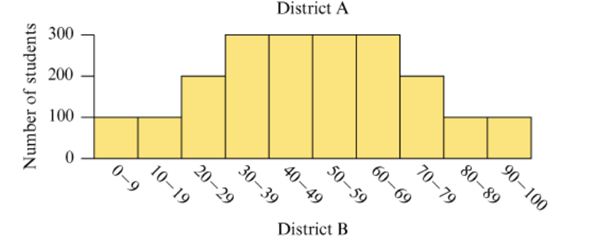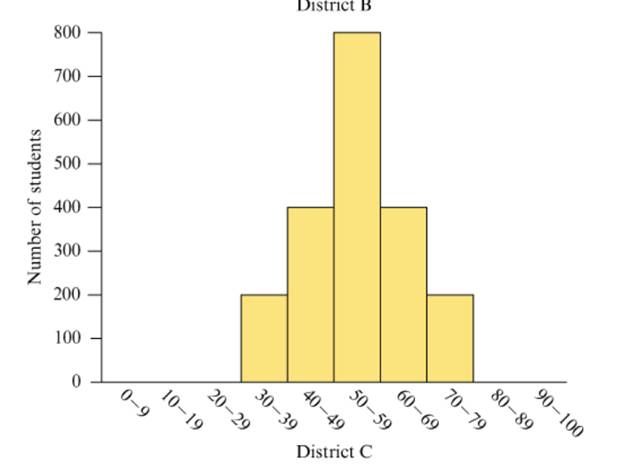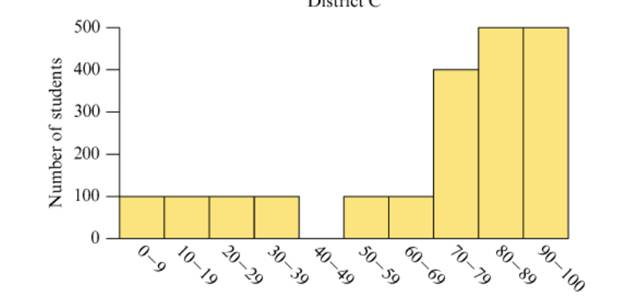
Concept explainers
The three histograms in Figure 15.37 show the hypotheticalperformance of students in three different school districts on thesame test. A score below 40 on the test is considered failing. Ascore of 80 or above is considered excellent.



Figure 15.37 Performance of three hypothetical schooldistricts on a test.
a. Estimate the mean score on the test for each school district by viewing the mean as a balance point, as discussed in Section 15.3.
b. Discuss what information you can glean from the histograms that wouldn’t be apparent just from knowing the mean or median scores on the test.
c. Discuss how each school district could argue that it did better than at least one other school district.
Want to see the full answer?
Check out a sample textbook solution
Chapter 15 Solutions
Mathematics for Elementary Teachers with Activities, Books a la carte edition (5th Edition)
- For what values of k will the equation (k + 1)x² + 6kx + 2k² - x = 0 have: a) one root equal zero b) one root the reciprocal of the other c) roots numerically equal but of opposite signarrow_forward3. The total profit (in dollars) from selling x watches is P(x)=0.52x²-0.0002x². Find and interpret the following. a) P(100) b) P'(100)arrow_forward3. Find the slope and the equation of the tangent line to the graph of the given function at the given value of x. -4 f(x)=x-x³;x=2arrow_forward
- 2. Find the equation of the tangent line to the graph of the given function at the given point. f(x)=(x+3)(2x²-6) at (1,-16)arrow_forward6. Researchers who have been studying the alarming rate at which the level of the Dead Sea has been dropping have shown that the density d (x) (in g per cm³) of the Dead Sea brine during evaporation can be estimated by the function d(x)=1.66 0.90x+0.47x², where x is the fraction of the remaining brine, 0≤x≤1. a) Estimate the density of the brine when 60% of the brine remains. b) Find and interpret the instantaneous rate of change of the density when 60% of the brine remains.arrow_forward5. If g'(5) 10 and h'(5)=-4, find f'(5) for f(x)=4g(x)-2h(x)+3.arrow_forward
- 2. Find each derivative. Write answers with positive exponents. a) Dx 9x -3 [97] b) f'(3) if f(x) = x²-5x² 8arrow_forwardT3.2: Prove that if the Graceful Tree Conjecture (every tree has a graceful labeling) is true and T' is a tree with m edges, then K2, decomposes into 2m - 1 copies of T. Hint - Delete a leaf to get 7" and apply the decomposition of K2(m-1)+1 = K2m-1 into T'. Then explain how the decomposition allows the pendant edge to be added to a new vertex to obtain a decomposition of K2m into copies of T.arrow_forwardUse the matrix tree theorem to determine the number of spanning trees of the graphs Kr∨sK1.These are the graphs formed by by adding all edges between a complete graph on r vertices and atrivial graph (no edges) on s vertices.arrow_forward
- The maximum capacity spanning tree problem is as follows for a given graph G = (V, E) withcapacities c(uv) on the edges. The capacity of a tree T is defined as the minimum capacity of anedge in T. The maximum capacity spanning tree problem is to determine the maximum capacity ofa spanning tree.(i) Describe how to modify the input graph to find a maximum weight spanning tree making use ofa minimum weight spanning tree algorithm.(ii) Show that a maximum (weight) spanning tree is also a maximum capacity spanning tree.(iii) Is the converse of part (ii) true? That is, is it true that a maximum capacity spanning tree is alsoa maximum spanning tree? Either give counterexamples (of all sizes) or a proof.(iv) Prove the following max-min result. The maximum capacity of a spanning tree is equal to theminimum bottleneck value of a cut. For a subset U ⊆ V , the cut [U, V − U] is the set of edgesbetween U and V − U. The bottleneck value of a cut [U, V − U] is the largest capacity among theedges of…arrow_forward1) Find The inverse The domain of m(x) = tion and of the function The inverse function 3- √x-aarrow_forwardProve that the following version of a greedy algorithm produces a minimum spanning tree in aweighted graph. Start with a vertex v as the initial tree and at each stage add an edge with minimumweight having exactly one end in the current tree. Stop when all vertices have been addedarrow_forward
 Glencoe Algebra 1, Student Edition, 9780079039897...AlgebraISBN:9780079039897Author:CarterPublisher:McGraw Hill
Glencoe Algebra 1, Student Edition, 9780079039897...AlgebraISBN:9780079039897Author:CarterPublisher:McGraw Hill Big Ideas Math A Bridge To Success Algebra 1: Stu...AlgebraISBN:9781680331141Author:HOUGHTON MIFFLIN HARCOURTPublisher:Houghton Mifflin Harcourt
Big Ideas Math A Bridge To Success Algebra 1: Stu...AlgebraISBN:9781680331141Author:HOUGHTON MIFFLIN HARCOURTPublisher:Houghton Mifflin Harcourt Holt Mcdougal Larson Pre-algebra: Student Edition...AlgebraISBN:9780547587776Author:HOLT MCDOUGALPublisher:HOLT MCDOUGAL
Holt Mcdougal Larson Pre-algebra: Student Edition...AlgebraISBN:9780547587776Author:HOLT MCDOUGALPublisher:HOLT MCDOUGAL


